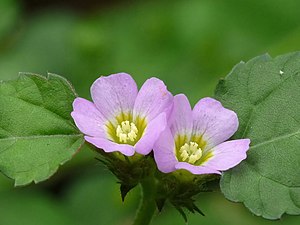Note: This is a project under development. The articles on this wiki are just being initiated and broadly incomplete. You can Help creating new pages.
Melochia corchorifolia
Melochia corchorifolia, the chocolateweed, is a weedy tropical plant that is typically seen in the wastelands. It has been most frequently observed to grow in open areas, such as highways.[1] Although Melochia corchorifolia does not have any common usage, it has been utilized as a homeopathic remedy. Its weedy and invasive characteristic inhibits its wider cultivation.
Contents
[hide]- 1 Uses
- 2 Parts Used
- 3 Chemical Composition
- 4 Common names
- 5 Properties
- 6 Habit
- 7 Identification
- 8 List of Ayurvedic medicine in which the herb is used
- 9 Where to get the saplings
- 10 Mode of Propagation
- 11 How to plant/cultivate
- 12 Commonly seen growing in areas
- 13 Photo Gallery
- 14 References
- 15 External Links
Uses
Ear problems, Anthelmintic, Dysentery, Abdominal swellings, Snake bites, Tonic.
Parts Used
Chemical Composition
Leaves have been analyzed to have triterpenes (friedelin, friedelinol and β-amyrin), flavonol glycosides (hibifolin, triflin and melocorin), aliphatic compounds, flavonoids (vitexin and robunin), β-D-sitosterol β-D-glucoside and alkaloids. These naturally occurring alkaloids help in plant growth and contains nitrogen. [1]
Common names
| Language | Common name |
|---|---|
| Kannada | |
| Hindi | |
| Malayalam | |
| Tamil | |
| Telugu | |
| Marathi | NA |
| Gujarathi | NA |
| Punjabi | NA |
| Kashmiri | NA |
| Sanskrit | |
| English | Chocolateweed |
Properties
Reference: Dravya - Substance, Rasa - Taste, Guna - Qualities, Veerya - Potency, Vipaka - Post-digesion effect, Karma - Pharmacological activity, Prabhava - Therepeutics.
Dravya
Rasa
Guna
Veerya
Vipaka
Karma
Prabhava
Habit
Identification
Leaf
| Kind | Shape | Feature |
|---|---|---|
| Simple | Ovate leaves | the petioles are generally 5 cm long with linear stipules of 6 mm long. The veins extend to be from 7 cm long to 5 cm long. This plant is an annual or perennial type of herb. It usually develops to be up to 1.3–2.0 m tall; stem with line of stellate hairs. It’s simple, ovate leaves are normally arranged spirally with the margins very intensely serrated. The blade of the leaves range from narrow to broad to the tip, measures up to 7.5 cm × 5.5 cm. |
Flower
| Type | Size | Color and composition | Stamen | More information |
|---|---|---|---|---|
| Bisexual | 5–7 mm long | Purple | 5 | Regular with calyx campanulate of 3 mm long. It is also short-teethed and consists of petals of 8 mm long, white with yellow base inside. The stamens are fused close to the top of the filaments. This purple flower has superior ovary with 5 styles joint at the base. The flowering occurs from July to October. |
Other features
List of Ayurvedic medicine in which the herb is used
Where to get the saplings
Mode of Propagation
root.
How to plant/cultivate
The proliferation is completed via seed. It is often thought that germination can be better significantly by scarification. With scarified seed, germination is done at temperatures of 35–40 °C. Additionally, Melochia corchorifolia L is observed to be a host of fungal diseases, such as Rhizoctonia solani. [3]
Commonly seen growing in areas
Photo Gallery
References
External Links
- Ayurvedic Herbs known to be helpful to treat Ear problems
- Ayurvedic Herbs known to be helpful to treat Anthelmintic
- Ayurvedic Herbs known to be helpful to treat Dysentery
- Ayurvedic Herbs known to be helpful to treat Abdominal swellings
- Ayurvedic Herbs known to be helpful to treat Snake bites
- Ayurvedic Herbs known to be helpful to treat Tonic
- Herbs with Leaves used in medicine
- Herbs with Fruit used in medicine
- Herbs with common name in English
- Habit - Herbs
- Index of Plants which can be propagated by root
- Herbs that are commonly seen in the region of Garden area
- Herbs


